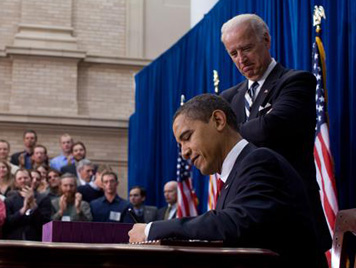Stimulus to aid Fogarty grantees
January - February, 2009 | Volume 8, Issue 1

Photo by Pete Souza, the White House
President Obama signs the American Recovery and
Reinvestment Act, which will increase Fogarty's grant-making.
Making good on the promise to elevate science and medical research, President Obama’s economic stimulus package provides $10 billion for the NIH. About 80 percent is designated for research, with a large portion of the rest to support facility construction.
“This recovery act represents the biggest increase in basic research funding in the long history of America's noble endeavor to better understand our world,” Obama said when he signed the bill.
A trans-NIH effort will make new awards for projects that address research questions that might be solved in two years.
Called NIH Challenge Awards, the initiative includes a number of themes submitted by Fogarty.
In addition, the agency will fund grant applications that had been deemed meritorious by peer-review but had not been awarded due to lack of funds. Supplements will also be made to existing awards.
The National Institutes of Health (NIH) and Fogarty will post details of the funding plans, as they develop, on their Web sites.
The President said he hopes the stimulus package “will ignite our imagination once more, spurring new discoveries and breakthroughs in science, in medicine, in energy, to make our economy stronger and our nation more secure and our planet safer for our children.”
NIH Acting Director Dr. Raynard Kington said, “We are confident that we can spend the funds that Congress has allocated both responsibly and quickly.” He said most projects under the stimulus will receive funding for a two-year period.
“The president’s words and actions certainly speak to our mission and should make our trainees abroad feel even more welcome and prouder of what they do,” said Fogarty Director Dr. Roger I. Glass.
In a radio speech to the nation (see Guest Opinion by President Barack Obama, Listening to what science says) and in his Inaugural address, Obama promised to “put science at the top of our agenda” and “restore science to its rightful place.”
“To the people of poor nations, we pledge to work alongside you to make your farms flourish and let clean waters flow; to nourish starved bodies and feed hungry minds,” he said after his swearing-in.
“And to those nations like ours that enjoy relative plenty, we say we can no longer afford indifference to suffering outside our borders; nor can we consume the world's resources without regard to effect. For the world has changed, and we must change with it.”
Shortly after taking office, Obama rescinded the “gag rule” that prevented U.S. family planning assistance from going to international organizations that perform abortions or counsel about them.
“We’ve never had a president surrounded in close proximity with so many well-known, top scientific minds,” former National Institute on Drug Abuse director Dr. Alan Leshner told The Economist.
Leshner now is chief executive officer of the American Association for the Advancement of Science, whose former president, Dr. John Holdren, has been named the president’s chief scientific adviser.
Other health and science appointees in the new administration include:
- Dr. Steven Chu, Nobel laureate in physics in 1997, to head the Department of Energy
- Dr. Jane Lubchenco, a marine biologist at Oregon State University, to head the National Oceanic and Atmospheric Administration
- Dr. Harold Varmus, former NIH director and current president of Memorial Sloan-Kettering Cancer Center, and Dr. Eric Lander, an MIT biologist instrumental in discovery of the human genome, to be co-chairs of the President’s Council of Advisers on Science and Technology, headed by Holdren.
Among items on the administration’s stated agenda that could affect Fogarty programs are:
- Lead an international effort to diminish impact of major infectious disease epidemics.
- Accelerate the development of new medicines, vaccines and production capabilities.
- Support investments in biomedical research, as well as medical education and training fields.
- Ensure that decision-makers have the information and communication tools they need to manage disease outbreaks.
- Expand U.S. presence by opening consulates in difficult corners of the world—particularly in Africa.
- Embrace the Millennium Development Goal of cutting extreme poverty and hunger around the world in half by 2015 and double foreign assistance to achieve that goal.
To view Adobe PDF files,
download current, free accessible plug-ins from Adobe's website.